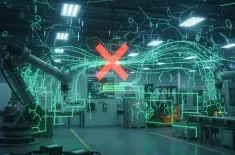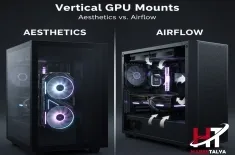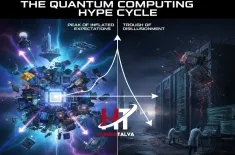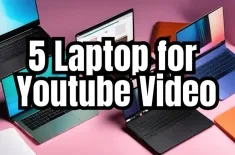Discover the best desktop computers of 2024 with our expert guide. Whether you're seeking high-performance gaming rigs or efficient workstations, we cover top picks that cater to various needs and budgets. Explore detailed reviews on performance, design, and value to help you choose the perfect desktop for gaming, work, or everyday use, ensuring the best tech investment.
What is the best desktop computer overall?
If you're looking for the top all-in-one desktop for most ordinary blokes and birds, Apple's new M3-powered iMac takes the biscuit. It's an all-singing, all-dancing beauty with a cracking 24-inch high-resolution display built right in, powered by Apple's spanking new M3 processor. This little beastie is a real pearler, churning through anything you throw at it with ease. And if you're after a bit more elbow room than your laptop offers, the 24-inch iMac gives you plenty of space to work and play. Yet, this little marvel is surprisingly nippy to move around the flat, thanks to its compact design and snazzy magnetic power cable. Oh, and did I mention it comes in seven jolly colours, with matching accessories to boot? Blimey, Apple really knows how to tickle the fancy!
Other Desktops for Different Strokes
Now, if you're not fussed on the all-in-one lark and fancy a traditional tower or a smaller machine, I haven't forgotten you. We've got cracking recommendations for those too, whether you're a Windows whizz or a ChromeOS champion.
Hands-on and Tested Recommendations
While laptops tend to hog the limelight here at Habertalya, desktops still strut their stuff in the CNET Labs from time to time. We base a fair few of our current recommendations on tried-and-tested versions we've reviewed in the past. We also dish out general PC configuration advice, even if we haven't specifically tested that exact setup. Trust me, our experience with similar computers means we know what's what. These guidelines should be a right handy guide if you're after the best bang for your buck when building your own custom PC. And of course, we'll keep this "best desktop computer" list spick and span with regular updates.
How We Test Desktops
We evaluate desktops in two steps – a bit like a cracking two-course meal. First up, they get a good grilling in the Habertalya Labs under controlled conditions. We throw all sorts of tests at them, like Geekbench, Cinebench R23, PCMark 10, and 3DMark, to see how their muscles hold up. And if it's a gaming rig, we'll give it a workout with Guardians of the Galaxy, The Rift Breaker, and Shadow of the Tomb Raider.
The second course is all about hands-on experience. Our reviewers use the desktop like they would their own, giving it a thorough test drive. They judge how everything fits together, from the design and features (screen, camera, speakers) to the manufacturer's software. We also consider the price point, looking for where corners might have been cut or upgrades made.
Of course, just like our tastes change, so do the tools we use for testing. As new kit emerges, we update our list of benchmarks and comparison points. If you're curious about the full menu, you can find all the gory details on our "How We Test Computers" page.
So, there you have it – the Habertalya way of putting desktops through their paces! Now, where did I put that cup of tea?
Factors to consider when buying a desktop computer
Right then, mates, let's chinwag about picking the best desktop for your needs. Whether you're a spreadsheet soldier or a graphics guru, there's a PC out there waiting to be your trusty tech sidekick. Buckle up and let's navigate the maze of specs and jargon!
Price: What's Your Budget, Bruv?
For most everyday tasks, you can snag a decent tower PC from Acer, Asus, Dell, or HP for around £400-£500. These bad boys will chug along happily for years, handling web browsing, emails, and even a dab of light gaming. Here's what we recommend for a basic Windows 11 rig:
- Processor (CPU): Intel Core i5 (12th or 13th gen) or AMD Ryzen 5 (5000, 6000, or 7000 series)
- Graphics: Integrated graphics like Intel UHD or Iris, or baseline AMD Radeon (unless you're a gaming fiend)
- RAM: 16GB or more – keeps things zippy!
- Storage: 512GB or bigger NVMe SSD drive – snappy and spacious
- Ports: Plenty of USB 3.1 or 3.2, including USB-C and USB-A (one or two on the front for easy access)
- Wireless: Wi-Fi and Bluetooth – ditch the wires, embrace the freedom!
- Expansion Slot: At least one PCI-E (x16) slot for future upgrades, like a beefier graphics card
Fancy yourself a gamer or a photo/video editing whizz? You'll need to level up the specs and expect to pay between £650-£950 (or even more if you want a bleeding-edge graphics card). Think:
- Graphics card (GPU): Nvidia RTX or AMD Radeon RX – unleash the graphics beast!
- RAM: 16GB or more – multitasking like a boss
- Power supply: 450 watts (or more) – feed the power hog!
Operating System: Windows vs. Mac (and the Odd Chromebox)
Microsoft Windows and Apple's macOS are the main contenders, both doing similar things but in different ways. Unless you need a specific app that only runs on one, go with the one you feel most comfortable with. Most desktops run Windows, while Apple's iMac, Mac Mini, Mac Studio, and Mac Pro use macOS. There's also the odd Chromebox running Google's ChromeOS, which is cheap and easy to use but can't run Windows or Mac software.
Processor: The Brains of the Operation
The CPU is the brainy bit that runs the show. Intel and AMD are the big names in Windows desktops, offering a dizzying array of processors. Head to their websites to pick one that suits your needs. Intel's current lineup is the 13th-gen Core chips, with 14th-gen on the horizon. AMD's latest chip is the Ryzen 7000 series. Generally, the faster the clock speed and the more cores, the better the performance. Macs take a simpler approach, with the Mac Mini sporting an M2 or M2 Pro chip and the new iMac rocking the M3. The Mac Studio gets fancy with either an M2 Max or M2 Ultra, and the Mac Pro is the ultimate powerhouse with the M2 Ultra. Again, more cores often mean better performance.
Graphics: Rendering Reality, One Pixel at a Time
The GPU handles all the visual wizardry, displaying what you see and speeding up graphics-heavy tasks (and even AI stuff these days). Macs have the GPU integrated with the M2 and M3 processors. For Windows desktops, there are two types: integrated (iGPU) and discrete (dGPU). iGPUs are built into the CPU, while dGPUs are separate chips with dedicated memory (VRAM) for extra oomph.
iGPUs are great for smaller PCs like all-in-ones and SFF rigs but aren't as powerful as dGPUs. Some games and creative software won't even run without a dGPU or enough VRAM. But for everyday tasks like browsing, streaming, and basic productivity stuff, an iGPU will do just fine. If you're a video editor, gamer, streamer, designer, or anything else that demands graphics muscle, you'll need a dGPU. Nvidia and AMD are the main players, with Intel offering some Xe-branded iGPU options.
Memory: Keeping Things Ticking Over
For keeping your mind (the computer's, that is) working tip-top, we recommend at least 16GB of RAM. That's where it stores all the open tabs, spreadsheets, and games you're juggling at once. If it only has 8GB, things can get sluggish, like trying to do the washing-up with one hand behind your back. Imagine having to swap plates back and forth between the sink and a muddy puddle – that's what happens when the RAM fills up and starts using the slower storage drive.
Tower PCs usually have extra slots for adding more RAM like topping up your toolbox, but all-in-ones and those smaller fellas might not. And even if they do, reaching those slots can be like trying to untangle Christmas lights after a sherry-fuelled party.
Storage
You might find budget PCs clinging to clunky hard drives like last year's Christmas cake, but fancy ones and gamers have mostly gone solid-state (SSD) now. They're like switching from a clapped-out banger to a sprightly little sports car – much faster! Cheaper ones can still be a bit sluggish, like that old banger trying to climb a hill, especially if you only have 8GB of RAM and it starts swapping data back and forth.
Get the biggest one you can afford, but 512GB should be enough for most folks. If you're a film buff or a gamer storing epic libraries, aim for 1TB or more. Tower PCs usually have room for adding another drive internally, like building an extension onto your garage. All-in-ones and those smaller ones might need an external drive or that fancy cloud storage to keep everything tidy.
Display
All-in-ones are neat space-savers, with the screen and all the bits and bobs tucked behind it. But you give up some upgrade options for that convenience. As for the screen itself, aim for a big one with a decent resolution. Think of it like getting a huge telly for the telly room – the bigger and sharper, the better! Here's a rough guide:
- 24 inches with 1,920x1,080 pixels (that's 2K, or 1080p)
- 27 inches with 2,560x1,440 pixels (1440p)
- 32 inches with 3,840x2,160 pixels (the granddaddy, 4K)
Best Desktop Computers 2024 Editor Picks
Choosing the right desktop computer can feel overwhelming with so many options available. This guide highlights five top choices for 2024, catering to various needs and budgets. Remember that specific models and configurations change frequently, so always check current reviews and prices before purchasing. These are representative examples of what to look for in each category.
Note: Because I cannot access real-time pricing and product availability, the specific models listed below are illustrative examples. Replace these with current top-performing models from reputable brands when researching your purchase.
1. Best Budget Desktop: [Illustrative Example: HP Pavilion Desktop TG01-0000xyz]
- Target User: Students, casual users, those needing a machine for basic tasks like browsing, email, and office work.
- Key Features: Intel Core i3 or AMD Ryzen 3 processor, 8GB RAM, 256GB SSD, integrated graphics.
- What to Look For: Prioritize a reliable processor and sufficient RAM for smooth multitasking. An SSD is essential for fast boot times and application loading. Integrated graphics are sufficient for basic tasks but won't handle gaming or video editing.
2. Best Mid-Range Desktop: [Illustrative Example: Lenovo IdeaCentre 5i]
- Target User: Casual gamers, students needing more power, users for photo and video editing, or those who need a balance of performance and affordability.
- Key Features: Intel Core i5 or AMD Ryzen 5 processor, 16GB RAM, 512GB SSD, dedicated NVIDIA GeForce GTX 1650 or AMD Radeon RX 6500 XT graphics card.
- What to Look For: A dedicated graphics card makes a significant difference for gaming and media editing. 16GB of RAM ensures smoother multitasking and better performance with demanding applications. A larger SSD (512GB or more) provides ample space for your files.
3. Best High-End Desktop: [Illustrative Example: CyberPowerPC Gamer Xtreme]
- Target User: Serious gamers, video editors, 3D modelers, and other professionals needing top-tier performance.
- Key Features: Intel Core i7 or AMD Ryzen 7/9 processor, 32GB RAM, 1TB+ NVMe SSD, high-end graphics card (NVIDIA GeForce RTX 3070 or 4070, or AMD Radeon RX 6700 XT or 7800 XT or better).
- What to Look For: A powerful CPU and GPU combination is crucial for high frame rates in games and fast rendering times for creative projects. 32GB of RAM is recommended for smooth multitasking and handling large files. A fast NVMe SSD is essential for quick load times. Consider a liquid cooling system for improved performance and stability.
4. Best Gaming Desktop: [Illustrative Example: Origin PC Chronos]
- Target User: Enthusiastic gamers who prioritize maximum performance at high settings in the latest games.
- Key Features: High-end Intel Core i7/i9 or AMD Ryzen 7/9 processor, 32GB+ RAM, 1TB+ NVMe SSD, high-end graphics card (NVIDIA GeForce RTX 4080 or AMD Radeon RX 7900 XTX or better), robust cooling solution.
- What to Look For: Prioritize the highest-performing graphics card within your budget. Fast RAM and a large, fast SSD are critical for smooth gameplay. A powerful CPU ensures the system doesn't bottleneck the GPU. Invest in a high-quality cooling system to prevent overheating.
5. Best All-in-One Desktop: [Illustrative Example: Apple iMac 24-inch (M1)]
- Target User: Users who value a compact, space-saving design with integrated display and minimal cabling. Great for everyday tasks, light creative work, and casual gaming.
- Key Features: Apple M1 or M2 chip, 8GB-16GB RAM, 256GB-512GB SSD, integrated graphics.
- What to Look For: An All-in-One is a convenient choice for those prioritizing space and simplicity. The integrated display offers excellent image quality. Choose a configuration with enough RAM and storage for your needs. Performance will be generally lower than dedicated tower systems.
Before You Buy
- Read reviews: Check multiple sources for unbiased opinions on specific models.
- Compare prices: Shop around to find the best deals.
- Consider upgradability: If you plan to upgrade components later, make sure the case allows for it.
- Check the warranty: A good warranty provides peace of mind.
This guide provides a starting point for your search. Remember to do your research and choose the desktop computer that best suits your individual needs and budget.



































